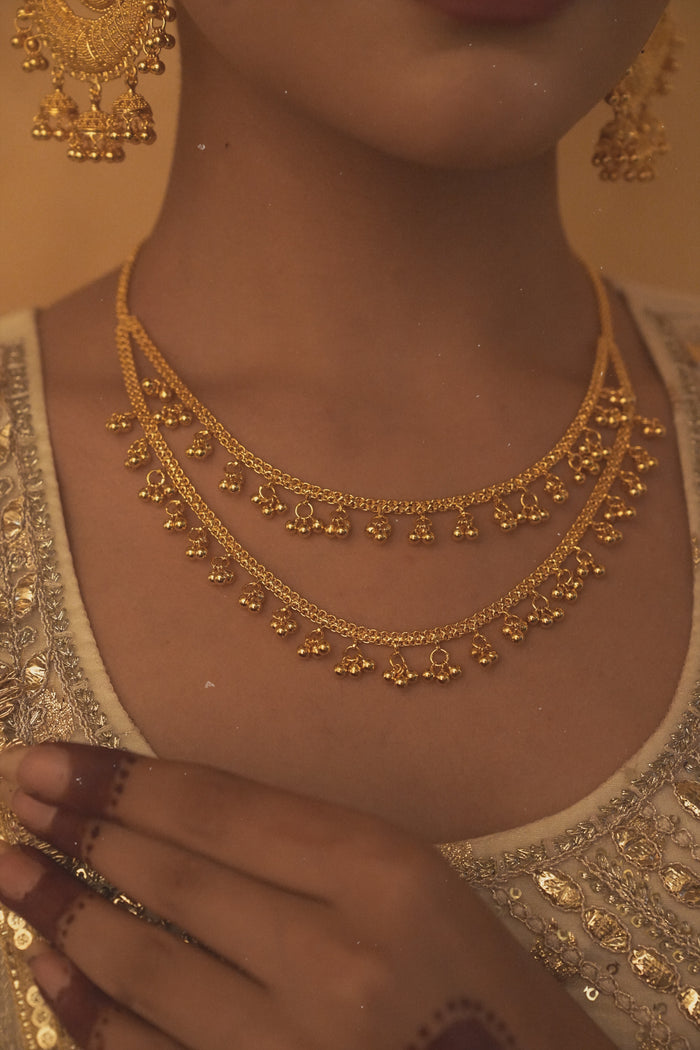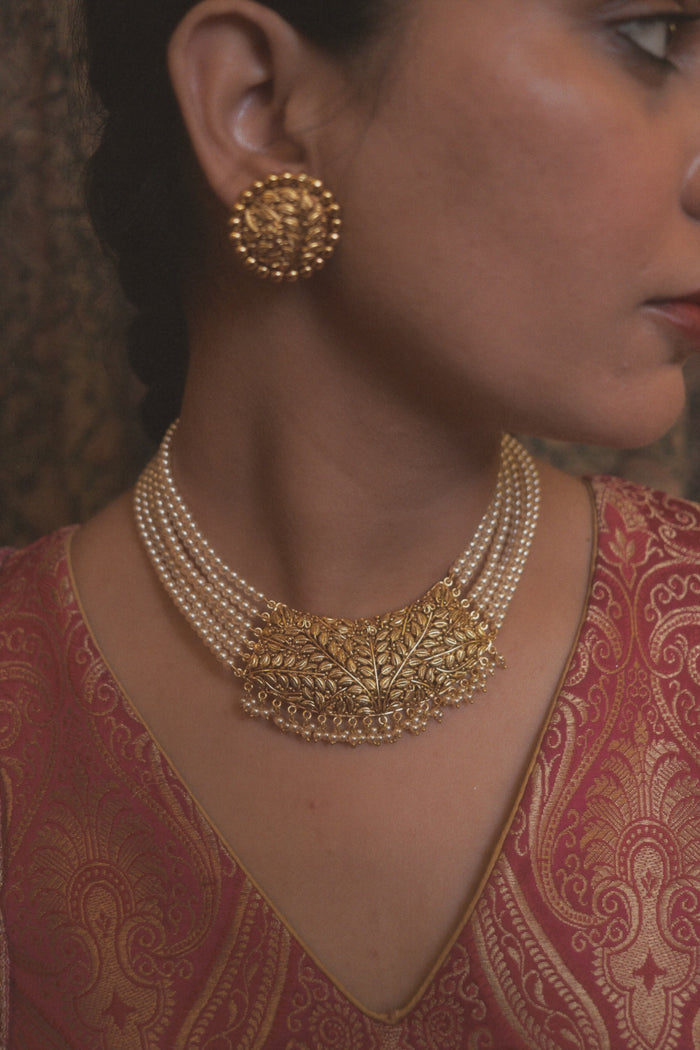Festive season in India carries its own kind of magic, homes light up, families gather and long-kept jewellery boxes finally open. Pieces that once belonged to grandmothers find their way into new celebrations. In this mix of nostalgia and joy, knowing how to style your jewellery becomes essential.
This jewellery styling guide is crafted for those who love pieces with history, depth, and cultural significance - jewellery that mirrors the aesthetic of Punjab’s heirloom artistry. Whether you’re dressing for a family gathering or the full jewellery for wedding season, the right styling can make your look feel intentional, rooted and truly festive.
Why Styling Traditional Jewellery Matters

Traditional jewellery carries weight - literally and emotionally. When styled thoughtfully, it elevates your entire look while keeping you comfortable.
It influences:
-
Comfort: Heritage pieces often have intricate goldwork; distributing weight well is important.
-
Expression: Jewellery communicates whether your look is classic, ceremonial, soft, or statement.
-
Balance: Heavy outfit + heavy jewellery can hide details; styling keeps everything harmonious.
-
Photographs: Necklaces, tikka, and earrings frame your face more than the outfit does.
Festivals are long events - you pray, dance, meet dozens of relatives, and pose endlessly for pictures. Your jewellery should feel like a part of you, not something you “manage” all day.
Start With One Heirloom Hero Piece

One rule every jewellery styling guide trusts:
Pick one main piece - let everything else support it.
For heritage-inspired jewellery:
-
If the necklace is heavy, pair it with simpler earrings.
-
If you love big chandbalis or jhumkas, skip the necklace and let the earrings shine.
-
If your bangles or kada stack is rich and layered, keep rings lighter.
This creates that polished, graceful festive balance seen in old wedding photographs and Punjabi heirloom portraits.
Match Jewellery With Your Neckline

Neckline decides the jewellery more than the outfit does.
Sweetheart, Round, or Deep U Necklines
These pair beautifully with traditional chokers, temple-style gold sets, or kundan collars.
They frame the neckline without overwhelming your outfit.
High-Neck or Closed Neck Suits
Go necklace-free.
Choose statement earrings or a matha patti - elegant and ceremonial.
Square Necklines
Straight, structured necklines sit well with structured chokers or heritage polki pieces.
One-Shoulder or Asymmetrical Designs
Avoid necklace clutter; choose jhumkas, haathphool, or bangles instead.
Choosing the Right Metal Tone

During the jewellery for wedding season, metal tone matters even more:
-
Gold: Best for reds, greens, maroons, mustards - the classics of Punjabi festive wear.
-
Antique Gold: Complements velvets, brocades, and rich jewel tones.
-
Kundan/Polki: Works beautifully with both traditional suits and lehengas.
-
Pearls: Perfect for day events, light ceremonies, and haldi tones.
Gold remains the most timeless choice for festive styling.
Avoid Looking “Too Much”
Traditional jewellery has a grand presence, so balance keeps it elegant.
A comfortable festive formula:
-
One highlight around the face (necklace OR earrings)
-
One accent on the hands (kada, bangles, or haathphool)
-
One subtle detail (tikka, nose pin, or delicate ring)
This ensures your look stays rich but not crowded.
Product-Based Styling Guide (Using Generic Heritage-Style Pieces)
Below is a practical styling section inspired by the kind of products available at Heritage Panjab - polki necklace sets, traditional jhumkas, matha pattis, bangles, kundan chokers, pearl earrings, and more.
1. Necklace Sets
Perfect for: weddings, family dinners, Diwali pujas
How to style:
-
Pair with a deep V or sweetheart neckline
-
Add small studs instead of heavy earrings
-
Go for soft glam makeup - polki reflects light beautifully
-
Keep hair tied or half-tied to let the neckline show
Why they work:
These pieces instantly elevate even the simplest suit or lehenga without feeling flashy.
2. Traditional Jhumkas
Perfect for: mehendi, musical nights, poojas
How to style:
-
Skip the necklace if the jhumkas are big
-
Add a matching bangle stack
-
Works best with braided hair or loose waves
Why they work:
Jhumkas bring movement into photos and make your face look more lifted.
3. Chokers
Perfect for: pastel lehengas, silk sarees, Anarkalis
How to style:
-
Wear with a clean neckline (square or deep U)
-
Add a maang tikka to complete the look
-
Keep earrings mid-sized for balance
Why they work:
Chokers sit beautifully on the collarbone and highlight your jawline.
4. Pearl Earrings or Pearl-Drop Pieces
Perfect for: day events, brunches, haldi, family gatherings
How to style:
-
Pair with pastel or floral outfits
-
Add bangles instead of a necklace
-
Works well with softer makeup
Why they work:
Pearls soften the face and pair well with nearly every festive colour.
5. Bangles & Kada Stacks
Perfect for: dancing, sangeet, casual festive nights
How to style:
-
Mix thin bangles with one statement kada
-
Match the metal tone to your earrings
-
Keep rings minimal
Why they work:
Hands are always moving during festivals - bangles add energy to your look.
6. Matha Patti or Tikka
Perfect for: weddings, traditional ceremonies
How to style:
-
Keep earrings light if the matha patti is heavy
-
Go for a clean center part
-
Works best with sleek hair or tied hair
Why they work:
They frame the face beautifully and add instant bridal or ceremonial charm.
Final Thoughts
Festive jewellery looks its best when styled with balance, cultural harmony, and respect for tradition. By understanding necklines, metal tones, and thoughtful pairing, your look feels effortlessly elegant and rooted in heritage - especially during the wedding season when jewellery carries deep meaning.
For those who cherish heirloom-inspired Punjabi craftsmanship, Heritage Panjab offers jewellery that preserves the beauty, artistry, and timeless soul of Punjab’s legacy.









